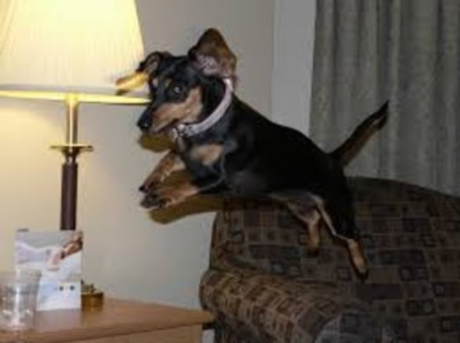
We all want to keep our dogs as fit and healthy as possible throughout their lives and well into their golden years. There are certain activities that, especially if indulged in repeatedly, do unnecessary damage to your dog. More and more we are recognising that repetition strain injuries, rather than one major event, are the underlying cause of many mobility problems. Many dogs like to do the same activity over and over and the type of injury varies with the activity. Knowing common activities that can cause damage and limiting how often your dog can do them is a sure way of reducing the incidence and severity of injury.
1. Overeating
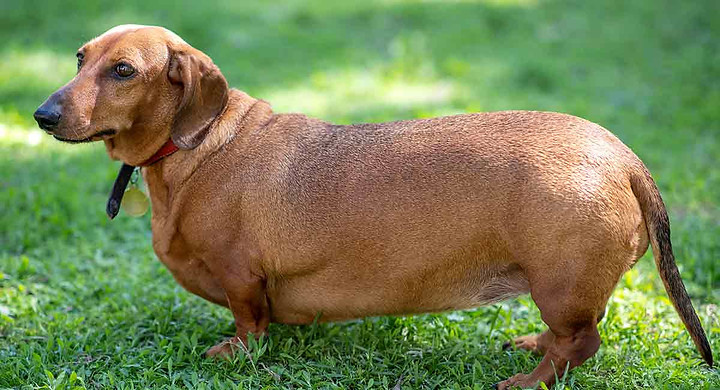
Yes, it’s official – if your dog eats more calories than they expend it will make them fat! As their mass increases the force on their joints, ligaments, tendons and muscles increase. It doesn’t sound like much, but a 20% increase in weight results in an equivalent increase in force for the same activity. That’s every step they take, every day. For a dog who should ideally weigh 10 kg that is just a 2 kg increase. For a dog who should weight 5 kg, it’s just 1 kg. The effect occurs over time so the longer they are overweight the worse it is. There are also times when it is more critical – for example when they are puppies and young dogs up to 18 months and when they are senior citizens (for more details see links to articles: 5 Top Tips for Exercising Older Dogs and Simple Rules for Exercising Puppies)
How do you tell if they are overweight? By look and by feel. Like us, their waist should be the narrowest part of their body. When they move you should be able to discern their last rib as they change position and direction. When you feel over their ribs that is exactly what you should feel – bone, not soft fat. Finally when you feel over their pelvis you should feel bone on either side of the backbone. These are the wings of their iliums – just like we have on the sides below our waist – and they should not be covered in fat.
2. Under exercising

This is commonly combined with over eating. Whereas increased weight causes increased force to the body, under exercising weakens the bone and supporting soft tissue. This means when they do exercise they are more prone to injury. A classic example of this is the under-exercised dog who spots a cat, rushes after it around a corner and ruptures a cruciate ligament. Under exercising also means that reflex responses are not as tuned as they should be. This in turn makes it more likely that falls and loss of balance will occur, again with the attendant increased risk of injury.
Of course, being over-weight and under exercising dramatically increases the risk of injury – more force on weaker, less responsive tissues. This is particularly the case with older dogs. Whilst it is tempting to let sleeping dogs lie it really is important to keep them moving. They don’t need to do much, just getting up and moving around is often enough. Sensory input is very important too, so going out to new places, driving to the park for a walk, even just having a ‘sniff-a-thon’ where it takes 20 minutes to walk 100 metres is very good for them. With regard to reflexes and balance slow is actually better than fast as it requires more precise control.
Exercise is especially important for the health of the cartilage that lines the ends of bones in joints and forms the intervertebral discs of the spine. This tissue has no blood vessels and relies on a process called imbibition to draw in nutrients and push out toxins. Think of a sponge – as you squeeze it fluid (toxins) come out, as it expands again it can draw fluid (nutrient) in. If there is no increase and decreases of pressure then there is no imbibition. If there is no imbibition there is no nutrition, only toxin build up.
3. Over exercising as a puppy
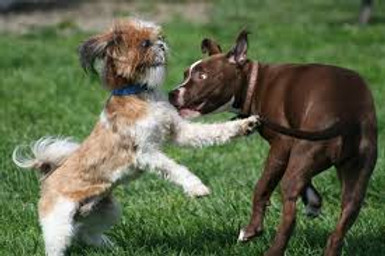
This is one of the most common reasons for chronic joint problems such as hip dysplasia and elbow dysplasia in later life. Puppies have no sense of what will cause them harm. It is logical to think that if something hurts they will stop doing it. But some dogs, especially as puppies, simply don’t respond that way. Instead their zest for life is such that they simply find another way of using their bodies to allow them to do whatever it is they want. So, if one leg starts to hurt they don’t stop running, they just shift their weight to another limb. We call this ‘compensation’. If both back legs hurt then they shift their weight to the front end and show very little if any lameness. By the time they are limping or clearly sore they have often already done irreparable damage to their joints. Again, the problem is exacerbated if they are concurrently overweight.
The critical time for controlling activity for puppies is from 12 weeks to 10 months, but they should have clear limits on their activity until the growth plates (the points at which the bones grow) are closed. This is from 15 – 24 months, sometimes even later in very large breed puppies. (For more information see the link to the article Simple Rules for Exercising Puppies)
4. Jumping down from rest
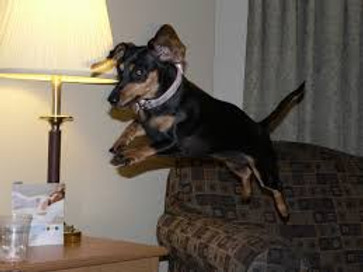
How many dogs love to find a raised resting place where they can watch the world go by? They lie there until they spot a potential ‘invader’ then, filled with adrenaline, they leap down, barking furiously, and rush to defend their territory! Excitement over, they go back to their sentry point to await the next threat.
Fun though this is it is actually potentially very damaging and the shoulder is particularly at risk. If they are at rest for any length of time then their muscles, tendons and ligaments are not primed for action and are therefore more vulnerable to damage. Gentle approximation of the activity about to be undertaken is the correct way to warm up – not sailing through the air to a hard landing and then running flat out! The fact that these resting areas are often raised is a problem as there is so much more force on their unprepared front legs. Additionally, if they are carrying any injuries already, such as arthritis, then the tissue may be swollen or inflamed and as such it cannot respond normally to the forces exerted upon it. It is much more likely to simply collapse under them, resulting in further damage. Finally, they are often too full of adrenaline to listen to the message their body is screaming at them – they just keep running. It is only on the return that they look uncomfortable and unhappy.
So fun though this activity is for your dog, try to discourage it. Make sure they can’t sit up high to watch – at least then they don’t jump down. Try to minimise the distance they can run to see off the invader. A bed on the floor in the window watching is much better than the sofa at the back of the room.
A similar problem also occurs if your dog travels in the car or sleeps on your bed or the sofa. When they have to get down they will be stiff and their tissue underprepared for the landing from the jump. Consider steps, a ramp or an ottoman or similar so that they can get down more gently – or lift them down if that is an option and won’t cause damage to your own back or joints!
5. Slippery floors
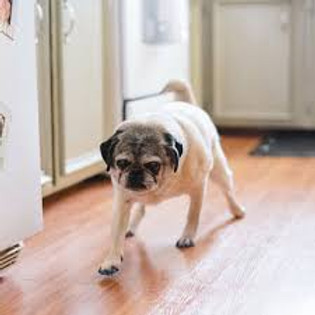
Doggy paws are simply not designed to give good traction on slippery surfaces. This is especially the case if they have long nails and lots of hair between the pads of their feet. In the northern hemisphere it is commonly ice that is the culprit, but in Australia it is more typically our love of tiled and wooden floors. The problem is exacerbated in older dogs who are more likely to suffer from muscle weakness and balance problems. The more anxious they become the more likely it is that they will tense up and try to grip with their toes. Of course, this only makes them more likely to slip and fall and this in turn is likely to result in injury.
Non-slip matting is very useful, as are rugs. Trimming nails and the hair on the underside of the paws is also helpful. You can buy toe grips – rubber rings that fit onto their nails to increase traction. You can buy boots with stippled bottoms to increase their grip. Or you can simply not let them run on the slippery floors!
Avoid these activities and your dog will stay healthy and mobile into their old age. In the next blog we will cover another 5 everyday activities that can damage your dog.
In the meantime – go out and have fun!
Disclaimer: The information in this article is general in nature and not intended to provide specific veterinary advice. If your dog has specific health issues a thorough physical examination by a trained veterinary professional is recommended. Veterinary clearance before instituting any new activity program is also recommended.
Author: Dr Sandra Hassett BVSc, MBA, MIVCA, CCRT

